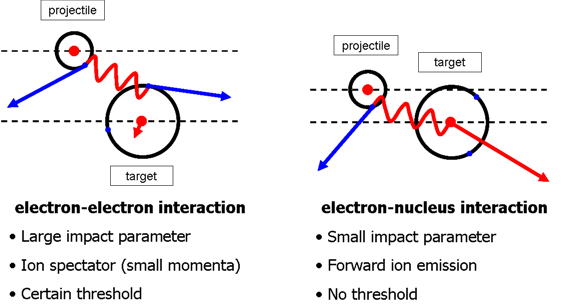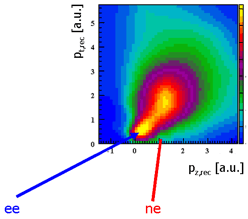Motivation
On the atomic scale, interaction is completely dominated by the electromagnetic force (photo ionization and charged particle impact). In charged particle impact ionization key role of the nucleus is to provide the coulomb potential. Besides a trivial shift of the center of mass frame, the mass of the nucleus plays no role. Absolute and differential cross sections are in general believed to be isotope independent.
In surprising contrast to that, Cooper and coworkers observed differences in quasi-elastic electron-scattering cross sections from gaseous H2, D2 and HD [1]. In comparison to the calculated intensities (Rutherford scattering theory) a decrease of approximately 30% of the integrated intensities of the H peak was observed (see figure on the right). Following these results the appropriate geometrical cross section seems to be smaller than expected. To shed more light on this unexpected result, we use a complete different approach.

Electron loss (projectile ionization)

COLTRIMS allows us to separate experimentally the contribution of ee (projectile electron - target electron) interaction from the en (projectile electron - target nucleus) interaction to the ionization of the projectile. In the ee process the projectile electron is knocked out by an interaction with the target electron while in the en process it is ionized by an interaction with the target nucleus. Depending on the impact energy one of these two processes dominates [2].

Measurement
In our experiment we use the COLTRIMS technology (cold target recoil ion momentum spectroscopy) to examine this electron loss process in collisions of He+ projectiles with a mixture of H2 and D2. Both electron-loss processes are separated in momentum space of the recoiling molecular hydrogen ions (see figure in “electron loss”).
The recoil ion momentum provides information about various processes, such as electron loss. A homogeneous electrical field caused by a spectrometer accelerates the charged fragments onto a position sensitive detector, so that 4 Pi acceptance angle can be reached.
The characteristical design of the spectrometer enables focussing in time-of-flight direction. The focussing is achieved by the use of a field free tube in which the particles can drift without any further acceleration. The spectrometer has an electrical field of 0.51 V/cm and a length of 23.6 cm plus 5.2 cm recoil drift. Further on also the projectiles can be detected on a position sensitive detector. Up to this point of our experiment they serve as a trigger for the coincidence setup.

Results
Here we present our results at 750 keV projectile energy, plots for 1000 and 1200 keV look similar. Further measurements at lower projectile energies and higher resolution are planned. Both molecules are separated in time-of-flight as well as in position space (figure a and b). For comparison with earlier measurements the recoil ion momenta transverse and parallel to the incident beam direction (z-axis) were plotted (figure c, d).

The transverse momenta of both recoil ions were normalized to their maximum for qualitative comparison. It's not quite sure yet if the obvious differences are of the same origin as the effects reported by Cooper et al.

References
[1] G. Cooper, A. P. Hitchcock, C. A. Chatzidimitriou-Dreismann, Phys. Rev. Lett. 100, 043204 (2008)
[2] Dörner et al., Phys. Rev. Lett. Volume 72, number 20 (1994)
[3] M. S. Schöffler, diploma thesis, 2002, J. W. Goethe Universität Frankfurt
|





